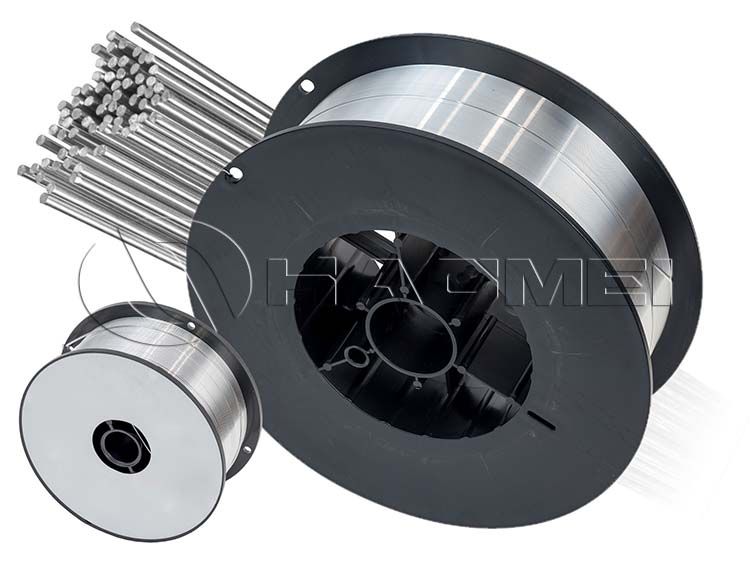Which Welding Methods Is Aluminum Filler Rod Applicable For
Marine aluminum welding wire (such as 5356, 5183, etc.) is based on aluminum-magnesium alloy. By optimizing the magnesium content (4.5%-5.5%) and adding trace elements such as titanium and chromium, the following key properties are achieved:
Seawater corrosion resistance: The magnesium content (4.3%-5.2%) and chromium content (0.05%-0.25%) of 5183 welding wire make its corrosion resistance in salt spray environment more than 30% higher than that of ordinary aluminum welding wire.
High strength matching: The tensile strength of 5356 welding wire can reach 250MPa, which is suitable for welding marine aluminum alloy plates such as 5083 and 5454, and the weld strength can reach 85% of the parent material.

Five welding methods suitable for aluminum welding wire
1. TIG welding
Technical advantages: It uses AC power supply (14-16V) and pure argon protection (flow rate 10-15L/min), and uses the cathode crushing effect to remove the oxide film, which is particularly suitable for welding 3-12mm thick marine aluminum plates. TIG aluminum filler rod is used during this process.
Process parameters:
Tungsten electrode diameter: 2.4-3.2mm (cerium tungsten electrode)
Welding current: 120-180A (AC)
Welding speed: 8-12m/h
Typical applications: ship superstructure, refrigerated container liner, LNG ship cryogenic pipeline.
2. MIG welding
High-efficiency welding: Using DC reverse connection (16-20V) and sub-jet transition technology, the deposition efficiency is 2-3 times higher than TIG welding.
Process parameters:
Wire diameter: 1.2-1.6mm
Welding current: 145-165A (reverse welding)
Shielding gas: pure argon (purity ≥ 99.9%)
Typical applications: hull segment welding, deck splicing, liquid cargo tank structure.
3. Friction stir welding (FSW)
Solid-state welding: Through the rotating stirring head (speed 1000-1500rpm), non-molten pool welding is achieved, avoiding the porosity and deformation problems of traditional fusion welding. For example, the welding deformation of 5mm thick 5083 aluminum alloy can be controlled within 0.5mm.
Technical features:
Joint strength: can reach more than 90% of the parent material
Weld appearance: no spatter, surface roughness Ra≤6.3μm
Typical applications: ship decks, cabin bulkheads, LNG ship liquid cargo tanks.
4. Explosive welding (EXW)
Dissimilar metal connection: Using explosive energy to achieve aluminum-steel connection, the bonding strength can reach 200MPa. For example, the connection between aluminum alloy superstructure and steel hull can withstand a shear force of 1000N/mm by explosive welding.
Process advantages:
Joining interface: wavy, excellent fatigue resistance
Heat-affected zone: width < 0.1mm, little effect on parent material performance
Typical applications: connection between ship superstructure and hull, pipe transition joint.
5. Submerged Arc Welding (SAW)
Thick Plate Welding: Granular flux (such as F5A2-EM12K) and DC reverse connection (30-35V) can be used to weld aluminum plates thicker than 20mm.
Process parameters:
Welding wire diameter: 4.0-5.0mm
Welding current: 500-600A
Welding speed: 25-30cm/min
Typical applications: ship keels, large liquid cargo tank structures.
Classification Society Certification
DNV GL certification: requires the tensile strength of the welding wire to be ≥250MPa, the elongation to be ≥8%, and the salt spray corrosion test (ASTM B117) to be 720 hours without obvious corrosion.
ABS certification: specifies the chemical composition of the welding wire (such as Mg≥4.5%), the impact toughness of the weld (-20℃≥27J), and passes the welding procedure qualification (WPS).
As a marine aluminum sheet supplier, Haomei Aluminum also provides aluminum welding wire. Welcome to inquire aluminum wire price per kg from us directly.
Original Source:https://www.marinealu.com/a/which-welding-methods-is-aluminum-filler-rod-applicable-for.html
Tags: aluminum welding wire ,